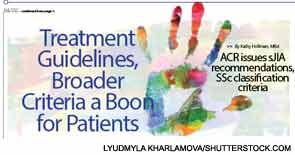
Two new documents from the ACR were released this October, representing the latest data and consensus about systemic juvenile idiopathic arthritis (sJIA) and systemic sclerosis (SSc). The first document, which details treatment options for sJIA, is the first update of the ACR’s recommendations on pediatric rheumatic disease that were released two years ago. The second document, a joint effort of the ACR and the European League Against Rheumatism (EULAR), provides classification criteria for early disease in the subset of patients with SSc.
2013 JIA Guideline Update
The 2013 Update of the 2011 American College of Rheumatology Recommendations for the Treatment of Juvenile Idiopathic Arthritis, published simultaneously in Arthritis & Rheumatism and Arthritis Care & Research, represents both the advances made in understanding the pathophysiology of sJIA and the rapid increase in clinical data from randomized trials about effective treatment.1 The recommendations were developed by an international panel of experts in JIA and pediatric rheumatology, as well as input from an expert in evidence-based medicine and a parent of a child with sJIA. The group used RAND/UCLA methodology.
Beyond updating the 2011 recommendations regarding use of nonbiologic and biologic disease-modifying antirheumatic drugs (DMARDs) in sJIA treatment, this new document gives updated information about starting nonbiologic and biologic DMARDs and treatment options for those patients with inadequate response to their initial therapy. Most important, it includes recommendations about using the newer interleukin (IL) 1 and IL-6 inhibitor therapies. Data about the inhibitors were not available in 2011.
Recommendations for Three Phenotypes
The 2013 update gives treatment recommendations for three sJIA phenotypes, which were developed from an evaluation of 1,226 scenarios. The phenotypes are defined as: 1) active systemic features and varying degrees of synovitis; 2) no active systemic features and varying degrees of synovitis; and 3) systemic arthritis with features concerning for macrophage activation syndrome (MAS). Additionally, the document provides recommendations about repeat annual tuberculosis (TB) screening among children with JIA who, at baseline, had a negative TB evaluation.
“For those pediatric rheumatologists with a firm knowledge of the supporting literature on the treatment of sJIA, these recommendations may or may not affect their clinical practice,” says Pam Weiss, MD, MSCE, assistant professor and attending physician in the division of rheumatology at Children’s Hospital of Philadelphia. “But for pediatric rheumatologists less familiar with the literature, for adult rheumatologists caring for kids, and for general pediatricians without access to pediatric rheumatology colleagues, these guidelines should be a valuable resource for providing recommendations for the most common sJIA phenotypes that we see,” she says. Dr. Weiss and Sarah Ringold, MD, MS, assistant professor at the University of Washington School of Medicine and attending physician at Seattle Children’s Hospital, were principal investigators and coauthors of the new recommendations.
